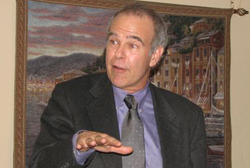Filed Under > Research/Publications
Understanding Education Research: Tips, Tools and Advice for Journalists from Teachers College
The Hechinger Institute teaches journalists how to access and understand education research. Its latest tool, "The Hechinger Institute Guide to Education Research for Journalists," is available on the Hechinger website at http://hechinger.tc.columbia.edu/.
At a conference sponsored by the Institute, Jeffrey Henig, a professor of political science and education at Teachers College, provided insight about how education research becomes news that filters down to the public. Henig used examples from his new book "Spin Cycle: How Research Is Used in Policy Debates, The Case of Charter Schools," (Russell Sage Foundation/The Century Foundation, 2008), to help reporters understand ways that research can easily be misunderstood or taken out of context.
The Hechinger Institute has been training journalists throughout the year to answer that question and others, through seminars and a new guide filled with tips on how to access and understand research.
The latest tool, “The Hechinger Institute Guide to Education Research for Journalists,’’ is available on the Hechinger website at http://hechinger.tc.columbia.edu/.
A generous grant from the Spencer Foundation, which focuses on investigating ways education can be improved around the world, has allowed the Institute to help journalists understand education research as a way of giving their stories more depth and authority.
Hechinger Institute Director Richard Lee Colvin believes the guide will elevate the work journalists do by providing context and data and exposing them to useful studies.
“Journalists who cover education need to recognize that research can provide them with sources of data, knowledge and explanations that can make their reporting more authoritative and useful to readers, listeners and viewers,’’ Colvin says.
For example, reporters covering a controversy over a reading curriculum should be able to find out – and tell the public -- what the research says about the curriculum. They should also be able to discern different methods used by researchers so they can compare conclusions in competing studies and understand what a study’s limitations are, Colvin says.
The 30-page research guide was written largely by Julia Denning, a research associate for the National Academy for Excellent Teaching at Teachers College, Columbia University. Copies can be ordered via email at Hechinger@tc.columbia.edu.
The Hechinger Institute/Spencer Foundation collaboration has provided other ways for journalists to learn more about covering and understanding research this year:
In March, the Hechinger Institute collaborated with the American Educational Research Association at AERA’s annual meeting in New York City. The Institute held workshops and sessions aimed connecting 18 journalists from papers such as the Washington Post and Chicago Tribune with senior research scholars. The collaboration also allowed the Hechinger Institute and AERA to identify the sessions that would be most useful and relevant to the journalists.
Deborah Stipek, dean of the Stanford University Graduate School of Education, urged reporters at the AERA conference in March to get a second opinion when reporting on any study, and suggested developing relationships with five or six senior scholars, deans or heads of research institutes who can help explain how new studies fit into existing literature.
Teachers College President Susan Fuhrman also met with the Hechinger journalists at the AERA conference, where she discussed the volume of essays she co-edited, “The State of Education Policy Research,’’ (Lawrence Erlbaum Associates, 2007) with David K. Cohen of the University of Michigan and Fritz Mosher of the Consortium for Policy Research in Education. Fuhrman discussed ways that education policy makers see and use research – and why journalists should ask pointed questions about how studies are done.
Gloria Ladson-Billings, an education professor at the University of Wisconsin-Madison, gave reporters at the AERA conference tips on how to navigate an education journal article, pointing out questions to ask about methodology, sample size, the researchers and limitations of the data.
As a featured dinner speaker at a joint AERA/Hechinger event, Jeffrey Henig, a professor of political science and education at Teachers College, provided insight about how education research becomes news that filters down to the public.
Henig used examples from his new book “Spin Cycle: How Research Is Used in Policy Debates, The Case of Charter Schools,’’ (Russell Sage Foundation/The Century Foundation, 2008), to help reporters understand ways that research can easily be misunderstood or taken out of context.
Finally, in July, Douglas D. Ready, an assistant professor of Education at Teachers College, reminded reporters to be skeptical and challenge education research during a workshop he ran at the McGraw Seminar for Reporters New to the Education Beat, held at Teachers College. Ready suggested asking pointed questions about everything from how the researchers chose their sample to how large the sample size is.
Teachers College is the largest graduate school of education in the nation. Teachers College is affiliated with Columbia University, but it is legally and financially independent. The editors of U.S. News and World Report have perennially ranked Teachers College among the nation's leading graduate schools of education.
Published Monday, Aug. 11, 2008
